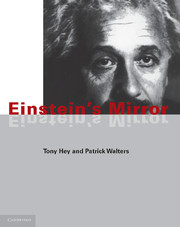Book contents
- Frontmatter
- Contents
- Preface
- 1 A revolution in time
- 2 The nature of light
- 3 Light and time
- 4 The ultimate speed
- 5 E = mc2
- 6 Matter and anti-matter
- 7 Little Boy and Fat Man: relativity in action
- 8 Down to earth
- 9 Warped space
- 10 The Big Bang, black holes unified fields
- 11 Afterword: Relativity and science fiction
- Appendix: Some mathematical details and derivations
- Chronology
- Glossay
- Quotations and sources
- Suggestions further reading
- Name index
- Subject index
- Plate section
6 - Matter and anti-matter
Published online by Cambridge University Press: 05 March 2013
- Frontmatter
- Contents
- Preface
- 1 A revolution in time
- 2 The nature of light
- 3 Light and time
- 4 The ultimate speed
- 5 E = mc2
- 6 Matter and anti-matter
- 7 Little Boy and Fat Man: relativity in action
- 8 Down to earth
- 9 Warped space
- 10 The Big Bang, black holes unified fields
- 11 Afterword: Relativity and science fiction
- Appendix: Some mathematical details and derivations
- Chronology
- Glossay
- Quotations and sources
- Suggestions further reading
- Name index
- Subject index
- Plate section
Summary
It is possible that radioactive processes may become known in which a considerably larger percentage of the mass of the initial atom is converted into radiations of various kinds than is the case for radium
Albert Einstein, 1907Prologue
In this chapter, we shall explore the application of special relativity to atomic physics. In order to make accurate quantitative predictions for the atomic structure underlying both physics and chemistry, it turns out to be essential to take into account ‘relativistic corrections’ to the standard quantum mechanical picture of the atom. Such applications of relativity form an important part of the experimental evidence supporting Einstein's theory, and to ignore them would give a distorted impression of its success. Thus, although this is a book about relativity, in order to appreciate this area of applied relativity, it is necessary to give a brief overview of our present understanding of atomic physics. A companion volume, The Quantum Universe, gives a fuller account of the development of quantum theory and its application to the modern world.
We begin our overview with an account of the great debate about the existence of atoms. In 1905, the same year that he published his paper on special relativity, the young Einstein made a crucial contribution to the debate with an atomic explanation of Brownian motion. At the same time as this debate was raging, the first discoveries about radioactivity were being made by Roentgen, Bequerel and the Curies. A major puzzle of the era was the origin of the energy released in radioactive decays.
- Type
- Chapter
- Information
- Einstein's Mirror , pp. 105 - 133Publisher: Cambridge University PressPrint publication year: 1997



